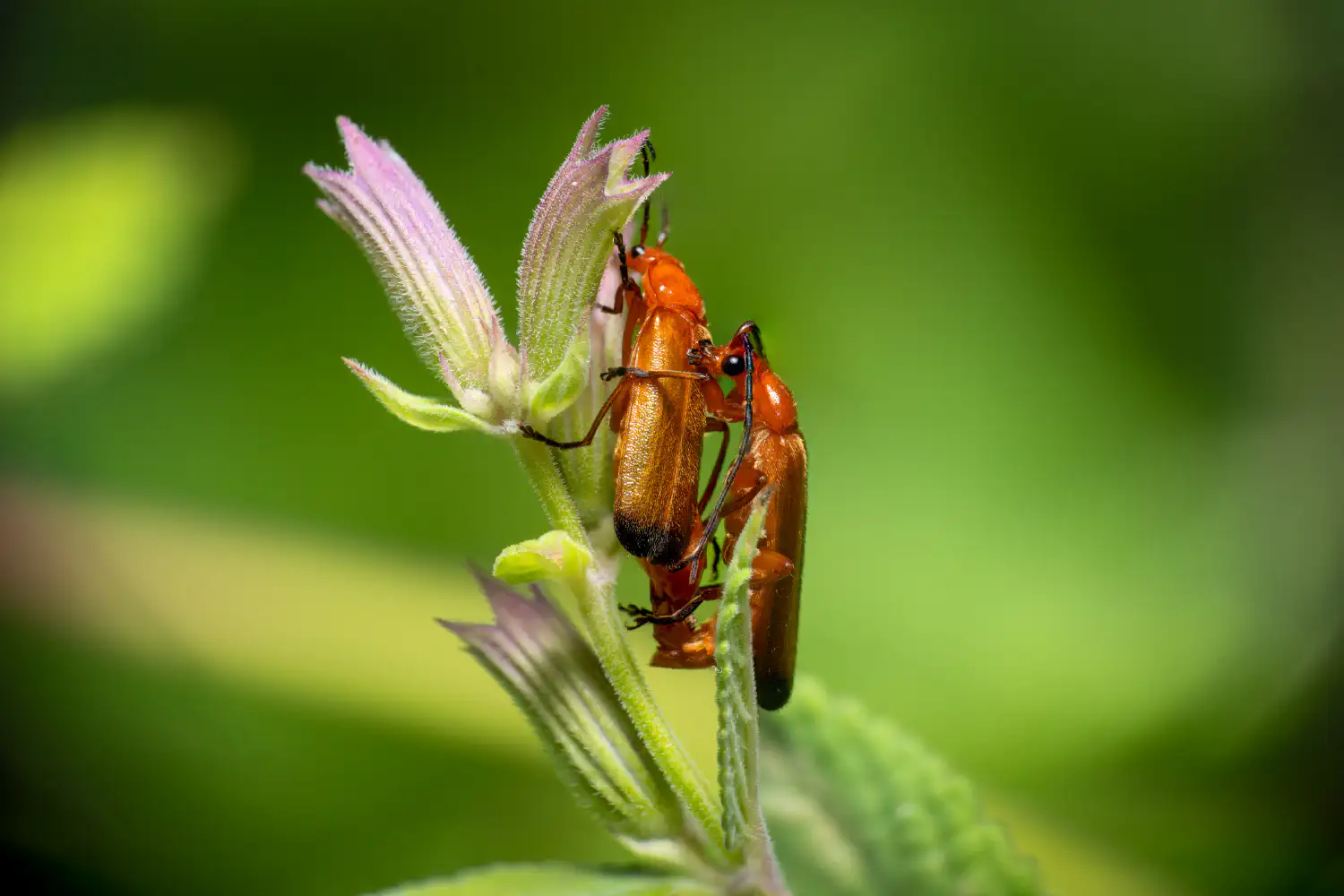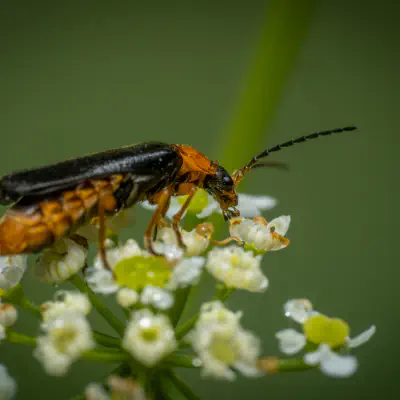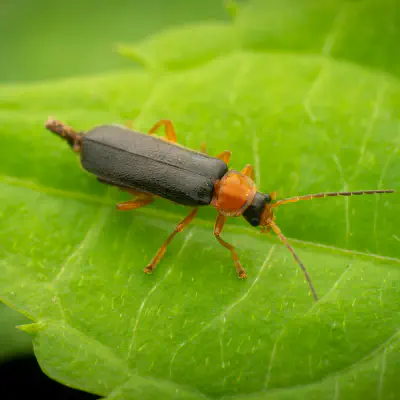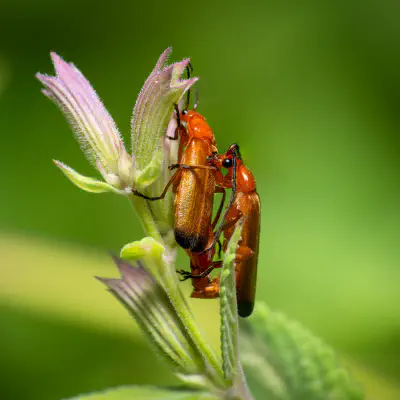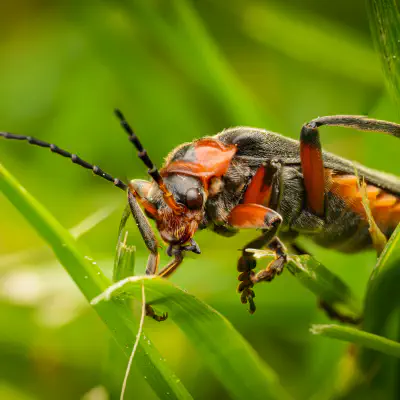Soldier Beetles
Lat. “Cantharidae“ The soldier beetles (Cantharidae) are relatively soft-bodied, straight-sided beetles. They are cosmopolitan in distribution. One of the first described species has a color pattern reminiscent of the red coats of early British soldiers, hence the common name. They are also known commonly as leatherwings because of their soft elytra.
Hierarchy Evolutionary history The oldest described member of the family is Molliberus from the Early Cretaceous (early Albian) aged El Soplao amber from Cantabria, Spain, belonging to the tribe Cantharini in the subfamily Cantharinae. Other described genera include 6 from the early Late Cretaceous (early Cenomanian) aged Burmese amber, with 5 belonging to Cantharinae and one to Malthininae, and Katyacantharis, from the Cenomanian aged Agdzhakend amber of Azerbaijan, suggested to belong to Cantharinae. Indeterminate specimens have been reported from the Aptian aged Koonwarra fossil bed of the Strzelecki Group, Australia and the Barremian aged Lebanese amber.
Subfamilies, tribes and selected genera Five subfamilies are normally accepted:
Reproduction Large males of the soldier beetle exercise choice for larger females. Body size correlates with the abilities of males to secure females, and of females to evade males.
See also List of Cantharidae genera
References Ancestry Graph %%{
init: {
'theme': 'base',
'themeVariables': {
'primaryColor': '#83a09c',
'primaryTextColor': '#212d2b',
'primaryBorderColor': '#fff',
'lineColor': '#fff',
'secondaryColor': '#006100',
'tertiaryColor': '#fff'
}
}
}%%
flowchart LR
classDef active fill:#fff
arthropods("phylum: Arthropods"):::active
arthropods-->insects("class: Insects"):::active
insects-->beetles("order: Beetles"):::active
beetles-.->ant-like-flower-beetles("family: Ant-like Flower Beetles")
beetles-.->checkered-beetles("family: Checkered Beetles")
beetles-.->click-beetles("family: Click Beetles")
beetles-.->darkling-beetles("family: Darkling Beetles")
beetles-.->false-blister-beetles("family: False Blister Beetles")
beetles-.->false-flower-beetles("family: False Flower Beetles")
beetles-.->fruitworm-beetles("family: Fruitworm Beetles")
beetles-.->ground-beetles("family: Ground Beetles")
beetles-.->jewel-beetles("family: Jewel Beetles")
beetles-.->lady-beetles("family: Lady Beetles")
beetles-.->leaf-beetles("family: Leaf Beetles")
beetles-.->longhorn-beetles("family: Longhorn Beetles")
beetles-.->net-winged-beetles("family: Net-winged Beetles")
beetles-.->sap-feeding-beetles("family: Sap-feeding Beetles")
beetles-.->scarabs("family: Scarabs")
beetles-.->shining-flower-beetles("family: Shining Flower Beetles")
beetles-.->skin-beetles("family: Skin Beetles")
beetles-.->soft-winged-flower-beetles("family: Soft-winged Flower Beetles")
beetles==>soldier-beetles("family: Soldier Beetles"):::active
beetles-.->straight-snouted-weevils("family: Straight-snouted Weevils")
beetles-.->true-weevils("family: True Weevils")
click ant-like-flower-beetles href "/en/catalogue/arthropods/insects/beetles/ant-like-flower-beetles/"
click checkered-beetles href "/en/catalogue/arthropods/insects/beetles/checkered-beetles/"
click click-beetles href "/en/catalogue/arthropods/insects/beetles/click-beetles/"
click darkling-beetles href "/en/catalogue/arthropods/insects/beetles/darkling-beetles/"
click false-blister-beetles href "/en/catalogue/arthropods/insects/beetles/false-blister-beetles/"
click false-flower-beetles href "/en/catalogue/arthropods/insects/beetles/false-flower-beetles/"
click fruitworm-beetles href "/en/catalogue/arthropods/insects/beetles/fruitworm-beetles/"
click ground-beetles href "/en/catalogue/arthropods/insects/beetles/ground-beetles/"
click jewel-beetles href "/en/catalogue/arthropods/insects/beetles/jewel-beetles/"
click lady-beetles href "/en/catalogue/arthropods/insects/beetles/lady-beetles/"
click leaf-beetles href "/en/catalogue/arthropods/insects/beetles/leaf-beetles/"
click longhorn-beetles href "/en/catalogue/arthropods/insects/beetles/longhorn-beetles/"
click net-winged-beetles href "/en/catalogue/arthropods/insects/beetles/net-winged-beetles/"
click sap-feeding-beetles href "/en/catalogue/arthropods/insects/beetles/sap-feeding-beetles/"
click scarabs href "/en/catalogue/arthropods/insects/beetles/scarabs/"
click shining-flower-beetles href "/en/catalogue/arthropods/insects/beetles/shining-flower-beetles/"
click skin-beetles href "/en/catalogue/arthropods/insects/beetles/skin-beetles/"
click soft-winged-flower-beetles href "/en/catalogue/arthropods/insects/beetles/soft-winged-flower-beetles/"
click soldier-beetles href "/en/catalogue/arthropods/insects/beetles/soldier-beetles/"
click straight-snouted-weevils href "/en/catalogue/arthropods/insects/beetles/straight-snouted-weevils/"
click true-weevils href "/en/catalogue/arthropods/insects/beetles/true-weevils/"
click arthropods href "/en/catalogue/arthropods/"
click insects href "/en/catalogue/arthropods/insects/"
click beetles href "/en/catalogue/arthropods/insects/beetles/"
Further Information
„Soldier Beetles“ on wikipedia.org
„Soldier Beetles“ on iNaturalist.org
Copyright 


